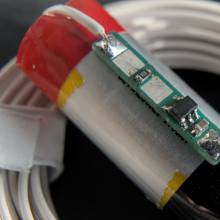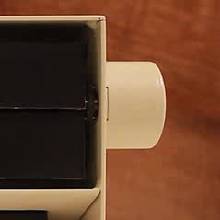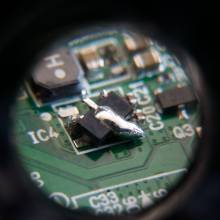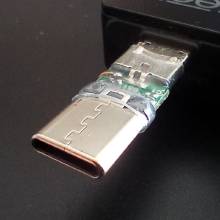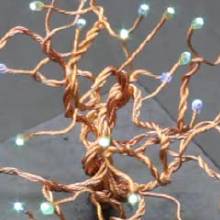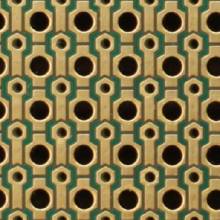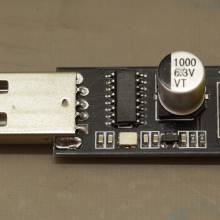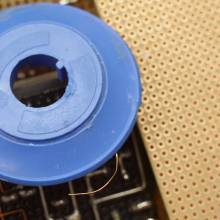Blog
This Is Where I Draw The Line
So I’ve had a pen plotter for quite a while now. It has shown up a few years back in a post on this site, where I used it for its intended purpose—recording X–Y curves. This plotter is quite a beast, it’s big (up to DIN A3) and heavy, and it’s unlike the majority of vintage plotters you’ll see people using online. This HP 7045A is fully analogue, which means it takes an X voltage and a Y voltage and directly controls the axis motors with analogue servo loops. In fact, it’s more correctly referred to as a recorder, rather than a plotter, since its purpose is to record measurement charts.
Read more →Charlieplexing Nixie Drivers
Nixies are great. Delightfully simple in their principle of operation and absolutely unmistakable in their aura. The hard-to-imitate aesthetics do come at a cost: they are a bit inconvenient to drive from modern electronics.
Many tried-and-proven nixie driver circuits can be found online. Using the classic 74141. With individual high-voltage transistors and shift registers. Or multiplexing the nixies to save on driver electronics? Multiplexing of nixies is a controversial topic: while the benefits are clear, many argue that nixies wear out faster due to the high current peaks when multiplexed.
This post isn’t about nixie multiplexing, though.
Read more →Lithium Battery Protection for Small Projects
Lithium cells haven’t become the predominant power source for mobile electronics without reason. Circuits for their—very necessary—protection are naturally plentiful as well.
One particular weak point of many protection schemes, however, is deep discharge protection. Common practice is to discharge LiPo/LiIon cells no further than 3 V to not risk permanent damage. Yet, most protection ICs cut off only at 2.5 V, and you thus have to rely on additional battery voltage monitoring.
Read more →Es ist Mittwoch.
Sometimes blog posts just have to sit in the drafts for a while. This one had the opportunity to mature for about a year. The actual project lies back about two and half years by now. The pictures I have of it haven’t got any better in the meantime, so I might just as well hit ‘post’ on this split-flap calendar I built for a friend.
Most of the time, it doesn’t do much. Once a day, it advances by one flap and ⅐ of the time, it announces the day of the week, Wednesday.
Read more →Zoom H4n Pro Repair
A Zoom H4n Pro audio recorder found its way to me, non-working. Recordings seemed to be silent, but with loud enough input you could just make out some distorted sound in the recording. After (unneccessarily) disassembling it completely, I found out that the power supply of the preamplifier board was sitting at around 0.8 V, which thankfully/boringly turned out to be the only fault in the unit.
Read more →USB-C to Micro-USB Adapters
I have a Seek thermal camera, which works by connecting it to a phone and using Seek’s app to display the image, take photos, etc. It’s an older model, from back when there were two variants, one with Micro-USB and one with Lightning. I’m on my third phone since I got it, which does not have a Micro-USB port any more. But it’s easy to get an adapter from USB-C, right?
Read more →Please Do Not Water This Tree
About two years ago, I made a little LED tree as a gift. An extremely simple design with 17 white 0603 LEDs soldered to magnet wire, twisted and bent to make branches, and combined them to a small LED bonsai. Electrically, all LEDs are wired in parallel and connected to 4.5 V via an LDR. This lets the tree react to the ambient brightness and helps it to great battery life.
Read more →A Better STM32F0 Prototyping Experience
This project started when I was particularly annoyed by existing development board options and cheap Chinese PCB prototyping services were starting to emerge. Thus, the path forward was clear, but let’s start with the problems I was trying to solve.
When I’m talking about ‘development boards’, I mean boards like the Teensy models, Feather variants or blue pill: a PCB based laid out around a microcontroller containing very little extra circuitry; a ‘least common denominator’ of typical projects using that MCU, if you will. Evaluation boards with more interesting circuitry are great to get used to a microcontroller and its peripherals but lie beyond the scope of this post.
Read more →ESP8266 Programmer
For the software side of some ESP8266 development, I bought a cheap ESP01 to USB adapter from AliExpress, expecting a programming adapter. What turned up on my doorstep, however, was just a USB-UART adapter which wasn’t able to drive the reset and GPIO0 pins. Luckily, the missing circuitry could be added easily.
Read more →Using Desoldering Braid Bobbins for Bodge Wires
Don’t throw spent desoldering braid spools away! The bobbins are great for hand wiring prototypes and doing PCB repairs. They have the perfect size, and unlike a regular spool, the magnet wire won’t uncoil itself all the time.


